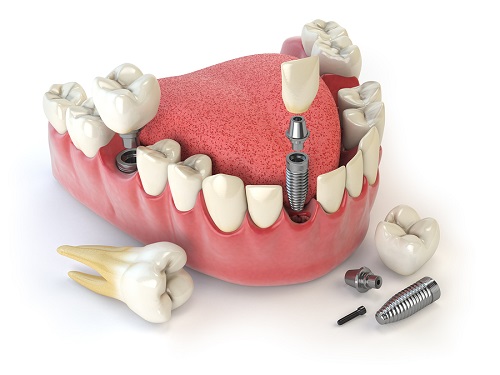Dental Implants Before and After: Knowing When it’s Time and What to Expect Afterwards
Tooth loss is often a fact of life and between 100,000 to 300,000 dental implant treatments are carried out each year.
Tooth loss can happen as a result of trauma, disease, a poor diet, or aging, and dental implants are often used in cases when a tooth must be removed. Studies show that nearly 70% of middle-aged adults are missing one or more permanent teeth. The study also showed that, by the age of 74, nearly 30% of adults had lost every permanent tooth and other studies have shown that over 35 million people in the US are missing teeth, leaving them requiring dental implant treatment.
What’s more, with dental care against tooth decay and gum disease on the rise, more people typically find that their implants feel and work much like a normal tooth or crown, as opposed to dentures.
The first replacement teeth and implant dentistry were believed to have been carried out in ancient Egypt. There, people placed rocks or shells into peoples’ jaws to maintain their structure when teeth were missing. The Mayans also used dental implants, affixing shells into mouths to fill in any gaps.
In other areas, communities used carved bone, gold, shells, and stone as replacement teeth and to fix gaps in peoples’ smiles.
Now, with modern implant dentistry, we have four primary methods used in the dental implant process that work far better than standard dentures. These include blade form, ramus frame, subperiosteal form, and finally endosseous form, which is the most commonly used.
Endosseous implants are placed into the mandible or maxilla and are shaped like screws. Their job is to act as the root of the tooth.
A few factors to consider when looking at different dental implants are the length and diameter, the geometry, and the threads.
Many people are curious about how a dental implant procedure would go and it’s good to familiarize yourself with the process if this is surgery you’re considering. First, the doctor will take out your damaged tooth. Next, your jawbone will be prepped for surgery. At this stage, the doctor may administer a bone graft. They’ll do this if they believe your jawbone is a bit too thin or worn, to protect it from the pressure you’ll place on your jaw when you chew.
When your jaw heals, dentists will implant a metal piece in your jawbone by cutting into your gums and drilling a fairly deep hole into the bone so that the tooth will have a stable anchor. This will require a few months to heal. Some people choose at this stage to use a temporary denture so that they can resume going to work and attending social events. Now, you’re waiting for the bones to grow into the implant—a process called osseointegration. Once the bone and the new material have grown together, you’ll be ready to apply your normal teeth.
Sometimes, the dentist will put an abutment or dental bridge where the place your single tooth will be attached to. When the soft gum tissue and jaw bone in your mouth have begun to heal after a few weeks, dentists will mold your teeth and jaw so that they’re able to get the measurements of your teeth correct. Then, when your jawbone is ready, the surgeon will open up your gums again and place your new teeth. The amount of time this all takes will depend on the individual, though it often takes several months—it takes time for the new bone to generate in your jaw. At every stage, you’ll want to stick to food that is soft. The stitches your surgeon uses, if they are required, often won’t require removal. They’ll simply dissolve.
A few of the side effects as a result of this surgery may include swelling in your face and mouth, bruised-looking skin and gums, pain, and some bleeding. If you do notice anything that seems unusual, however, or you’re experiencing what seems like an excessive amount of pain or swelling, give your surgeon a call. You may require medication for the pain, or antibiotics if there is an infection. We don’t recommend smoking at all, as this will slow the healing process. You should also refrain from rubbing the area.
Wondering what kind of teeth you should get? Some people go for removable; these are a little bit like a denture so that you can take it out daily to clean it. These are teeth attached to plastic gums. The other option is fixed and involves gluing the artificial tooth in place more permanently. This works even when you have a couple of teeth that are missing.
People often find that dental implant procedures are a lot simpler than they’d imagined them to be. Patients often report that the whole process wasn’t as painful as they’d expected. These days, with the advances in implant technology, the procedure is becoming increasingly simple and side-effect free. Often, local anesthesia is used, though surgeons will sometimes choose to sedate patients if they or the patient feels it’s necessary.
Once the implants are in, you’ll want to make a plan for cleaning them. Immediate, short-term, and long-term aftercare are important so that your implants can remain healthy. You’ll also continue to see a dental hygienist for several months to ensure you’re staying on top of your routine. You can use products like this for cleaning your bridges and implants or this.
Most people don’t even find they need to take time off of work, though you might consider it as an option. One or two days is enough for many. We would recommend refraining from committing to any large events in the week following your procedure. We ask that patients don’t drive immediately after the appointment and recommend they ask a friend to drive them home. It can be nice to have a few over-the-counter painkillers at home so that you have the option to take them if you are in pain. Now’s the time to be strict with yourself when rinsing and do not disturb the implant site by touching it with your finger or tongue. Skip the gym or your run for a couple of days and avoid other forms of physical exertion.
A lot of people emerge from surgery feeling great, only to wake up the next day with a swollen face. It’s normal for swelling to peak in two or three days, which you can address with ice packs. Use them for 15 minutes, take a break for 15 more, and resume icing. Repeat this cycle until the swelling has gone down. You can expect to feel some minor discomfort that dissipates over the next few days. If the pain worsens or the swelling intensifies, you should get in touch with your surgeon immediately. Make sure you stay hydrated and get plenty of rest.
Medically Fact-Checked & Written by Our Dental Editorial Team
You can read more about our editorial guidelines by clicking this link and learn more about the Emergency Dentists USA editorial team here.





